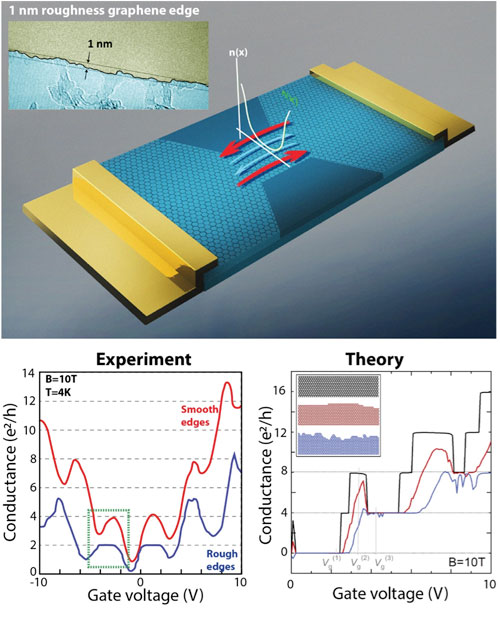| Posted: Feb 13, 2018 | |
Perfect edges in graphene devices sabotage the Hall effect |
|
| (Nanowerk Spotlight) Since its discovery in 1879 by Dr. Edwin Herbert Hall, the Hall effect has been a hallmark (pun intended) of electrical conduction. In a magnetic field, electrons are forced to move along the walls of the conductor, causing a circulating edge current. The transverse Hall resistance is proportional to the magnetic field, making the Hall effect widely used for magnetic field sensors. | |
| This incredibly robust effect has a quantum counterpart in high quality two-dimensional electron systems, such as for instance graphene. Here the circulating currents evolve into quantum mechanical edge states that each carry a current that is fixed by natural constants, the electron charge e and the Plancks constant h. | |
| With the naturally two-dimensional conductor graphene, the Quantum Hall resistance is locked within one tenth of a billion (1010) part to the fraction h/e2 , and stands to become the most accurate resistance measurement standard ever. | |
| A team of researchers from Denmark and Spain have looked closer at the Hall effect in narrow graphene devices – so-called graphene nanoribbons and nanoconstrictions. They were puzzled when they found that the quantization of the conductance was destroyed in some samples – especially because these particular samples were optimized for low edge disorder and low contamination. | |
| As it turned out, this effect had been predicted by several theoretical physicists twenty years ago, but largely ignored since no experimental evidence was ever found. | |
| In the experiments, Jose Caridad and coworkers compared nanoconstrictions etched with different recipes, and found that only the carefully tuned edges with edge roughness of down to 1 nanometer led to the disruption of the quantized current. Numerical calculations of transport through nanoribbons with different edge roughness confirmed this picture, and the question was now why this is happening. | |
| The carrier density in a graphene device is here controlled by an electrostatic field induced by a nearby metallic gate, as is often the case. The team found that the distribution of charge carriers, and thus the electrostatic potential, is highly sensitive to the edge morphology. On pristine, perfect edges, a much stronger charge accumulation occurs near the edges, and this distortion of the potential is what ultimately leads to formation of new edge channels inside the graphene device. These edge channels are much more sensitive to changes in the gate potential and the magnetic field, and ultimately sabotage the quantization characteristic of the quantum Hall effect. | |
 |
|
| The figure illustrates a graphene constriction, with a width of down to 50 nm. The perpendicular magnetic field causes strong edge currents (red arrows) to creep along the edges. Screening effects, however, induce charge accumulation at the edges, which becomes particularly sharp for pristine edges. The accumulated charges ultimately distort the electrostatic potential, allowing new edge states to appear (blue arrows). (Image: DTU) (click on image to enlarge) | |
| Peter Bøggild from the Technical University of Denmark believes that this is just the beginning: "This is just one recent example of an exciting development within two-dimensional materials science and technology right now. We see that an unexpectedly complex underlying behavior of two-dimensional materials is unmasked and unlocked, as we get better and better at engineering disorder-free two-dimensional material and devices. Also, the work emphasizes that in nanoscale devices, the atomic-scale shape and structure of the edges can have profound consequences for how the devices behave." | |
| The article was published on February 13 in Nature Communications ("Conductance quantization suppression in the quantum Hall regime"). | |
| The research was funded by EU Graphene Flagship project and the new CNG - Center for Nanostructured Graphene funded by the Danish National Research Foundation. | |
|
Provided as a Nanowerk exclusive by Technical University of Denmark (DTU)
|
|
|
Become a Spotlight guest author! Join our large and growing group of guest contributors. Have you just published a scientific paper or have other exciting developments to share with the nanotechnology community? Here is how to publish on nanowerk.com. |
|
